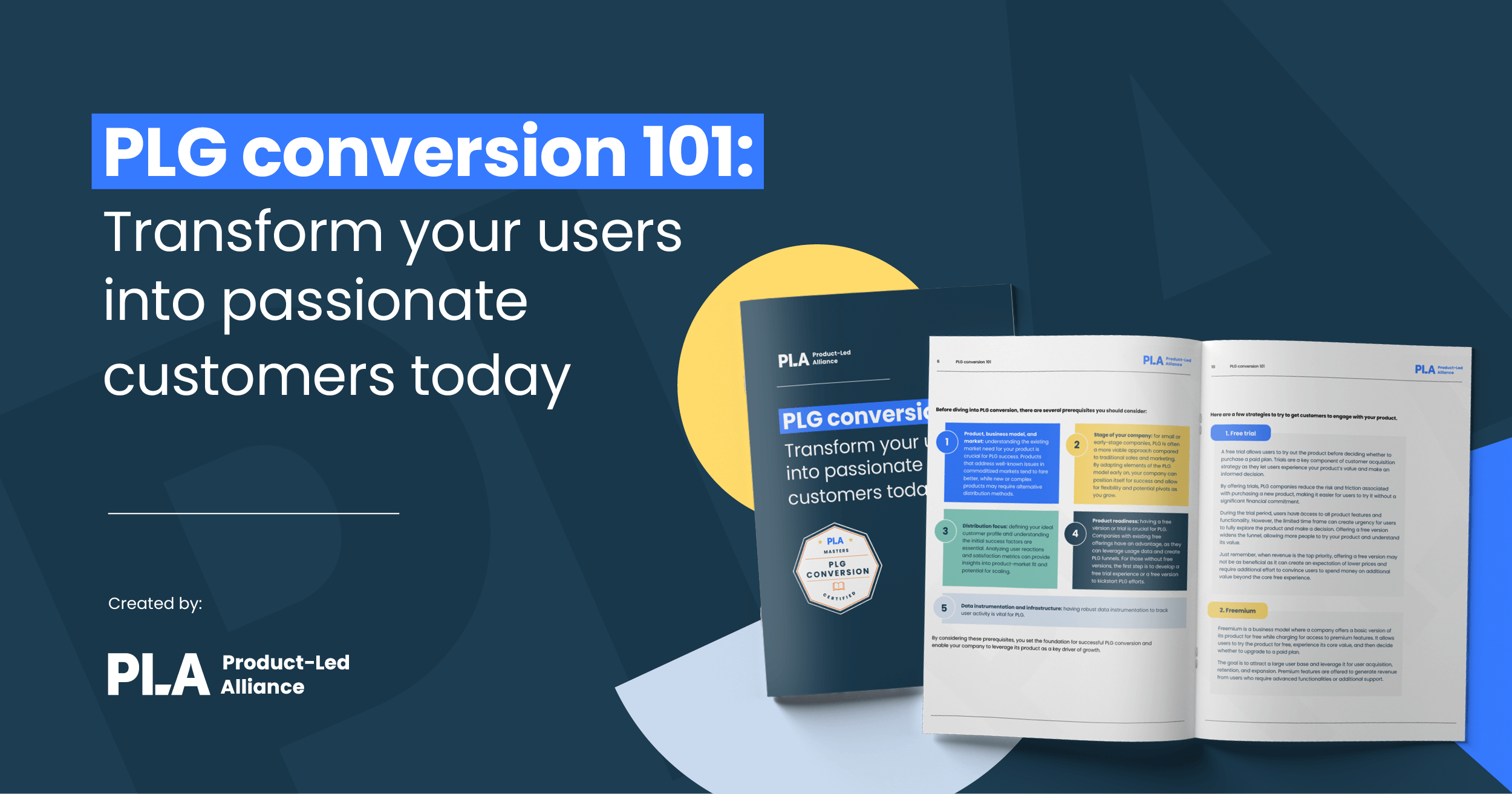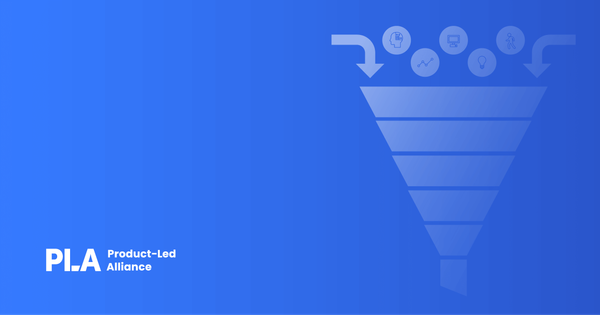Ever wondered how some businesses effortlessly attract, engage, and retain customers? That's the magic of PLG in action. It's like having your product do all the heavy lifting while you sit back and watch your user base grow.
Here, we're not about the fancy jargon or complicated strategies. We're all about keeping it simple and effective. Think of us as your trusty sidekick, guiding you through the ins and outs of PLG conversion. We've got the tools, tips, and tricks you need to take your business to the next level.
So, if you're ready to unlock the full potential of your product, join us on this exciting journey of growth and transformation. Let's make your product the talk of the town and revolutionize the way you do business.
What is product-led growth?
Product-led growth is a strategy that hinges on harnessing the qualities of a product to drive customer acquisition, retention, and expansion. To thrive in this approach, you need to deeply understand your customers and their journey, tailor your product to meet their needs and design a user experience that naturally fosters conversion and loyalty.
Elena Verna, a respected authority in product-led growth, encapsulates the essence of PLG by stating: "In product-led growth, users become advocates, essentially marketing the product themselves. They seamlessly transition to purchases or upgrades without direct human intervention, often due to the product's alignment with their interests, leading to enhanced personalization and value."
Traditionally, sales-led models dominated software industries, relying on personal relationships for customer acquisition. However, this method can be resource-intensive. In contrast, PLG emphasizes leveraging the product itself to attract users.
This shift, known as product-led or data-led growth, utilizes user activity data to refine outreach strategies. It's rapidly gaining traction in SaaS and micro-SaaS sectors, poised to redefine software sales methodologies.
Getting people hooked on the product
The primary aim of PLG is to entice users to sign up and explore the product. Following registration, the product and growth teams lead the onboarding process to ensure users extract maximum value. Simultaneously, revenue teams pinpoint sign-ups needing special attention.
Sign-ups fall into two categories:
- Self-service conversions are facilitated by promotions, incentives, notifications, or product enhancements.
- Those from larger firms necessitating sales aid.
Embracing PLG involves employing conversion strategies like free trials, freemium models, and reverse trials. All sign-up types are classified as product-qualified or product-not-qualified, denoting engagement level.
PLG emphasizes converting users who don't naturally convert and refining optimization strategies continuously.
Once you convert users, they’re overseen by Product and Customer Success teams, collaborating to transition them to Sales for upselling to higher service tiers. Though challenging, this success is absolutely attainable with the right methods.
Prerequisites
Before embarking on PLG conversion, it's essential to address several prerequisites:
- Product, business model, and market: Understand the market need for your product. Products addressing common issues in commoditized markets often perform better, while newer or complex products may require different distribution methods.
- Company stage: Small or early-stage companies often find PLG more viable than traditional sales and marketing. Adapting PLG elements early enables flexibility and potential pivots as your company grows.
- Distribution focus: Define your ideal customer profile and initial success factors. Analyzing user reactions and satisfaction metrics informs product-market fit and scaling potential.
- Product readiness: A free version or trial is crucial for PLG. Companies with existing free offerings leverage usage data to create PLG funnels. For those without, develop a free trial or version to kickstart PLG efforts.
- Data instrumentation and infrastructure: Robust data instrumentation to track user activity is vital for PLG success.
From sales-led to product-led
Transitioning from sales-led growth (SLG) to PLG introduces notable hurdles, particularly in these key areas:
- Sales team concerns: Sales teams often express concern regarding potential adverse effects on quotas and commissions due to PLG implementation. The fear of attracting a larger customer base with lower value is also ever-prevalent.
- Growth team integration: The growth team encounters challenges in seamlessly fitting into the overall go-to-market (GTM) workflow and forecasting of PLG. Building trust and understanding with other parts of the product organization becomes a crucial aspect of their integration.
To conquer these obstacles like a pro, it's essential to foster close alignment and collaboration among the sales and growth teams. This means acknowledging and resolving the specific concerns of each team while devising strategies to adjust workflows, define common metrics, and cultivate trust.
Facing resistance
When facing resistance, experimenting with PLG can be advantageous. Here are three strategies you should consider:
- Sales-assisted free offering: Introduce a free offering with sales assistance, enabling potential customers to engage with your product alongside a sales specialist. This bridges traditional sales-led approaches with a more product-centric model.
- Sidecar product as a lead generator: Develop a supplementary product to generate leads for your main offering. This product showcases value, attracting prospects and driving conversions.
- Product as a sandbox environment: Reposition your product as a sandbox for potential customers to explore within their buyer journey. This controlled interaction offers a glimpse into its capabilities while preserving some sales engagement.
Implementing these methods provides trial options without committing to a fully free service, facilitating PLG adoption and addressing concerns along the way. Before embracing PLG, define your problem and goals clearly.
Approach PLG strategically, understanding its significant investment and organizational impact. Evaluate PLG's suitability based on your goals and challenges, ensuring alignment with your strategic objectives for optimal outcomes.

PLG conversion strategies
There are many conversion strategies you can try to adopt PLG.
Looking at metrics is a huge driver of growth and helps identify what kind of business decisions you need to make. Two competing North Star metrics that drive success are:
User growth
Focuses on expanding the user base, fostering adoption, and ensuring users find value in the product. Metrics include weekly actives, monthly actives, or the number of accounts.
Revenue
Aims to monetize the user base by converting users into paying customers, maximizing revenue per user, and driving upsells or expansions.
Understanding the goals and priorities related to these metrics is crucial for growth teams. Strategies must align with either driving user growth or implementing revenue-focused initiatives.
Strategies to engage customers
Free trial: Allows users to experience the product before committing to a paid plan, reducing the risk associated with purchasing a new product.
Freemium model: Offers a basic version for free with premium features available for purchase. Attracts a large user base and generates revenue from users requiring advanced functionalities.
Reverse trial: Grants access to premium features temporarily, leveraging loss aversion to motivate users to upgrade to a paid plan. Careful communication is essential to avoid negative user experiences.
Both freemium and reverse trial models showcase product functionality without upfront payment, catering to different user preferences and revenue models.
Prioritizing user success and long-term value is critical for the success of these approaches. Strategic implementation and a deep understanding of user experience enhance conversion rates. Onboarding profiling and gathering key user information, such as demographics and persona, is vital for maximizing conversion rates and understanding user interactions.
Onboarding best practices
When implementing onboarding profiling, it’s best to prioritize the following:
Rule of three: Utilize three questions across three screens to efficiently gather information.
Multiple-choice options: Offer response options that require selection, reducing user effort and streamlining data collection.
Relevance: Focus on asking only pertinent questions that will enhance future user engagement. Provide context to aid user understanding.
Some recommended questions for onboarding profiling include inquiries about the user's role, seniority, use case, company size, and current tools. Understanding these details helps identify buyer personas, demonstrate competence, and facilitate integration or configuration of automation settings.
Don’t forget to understand your ideal customer profile(s), which is crucial for tailoring content, generating interest, and guiding users toward conversion and retention.
During onboarding, prioritize welcoming and understanding users. Try offering an intuitive, product-led experience aligned with existing messaging and clear value propositions. You want to guide users through necessary steps without overwhelming them and minimize unnecessary friction to ensure users recognize your product's value.
Combining in-product onboarding with email touchpoints can effectively drive your users back to the product and maximize the value derived from it.
Remember, onboarding should be viewed as an ongoing process to maintain positive customer experiences and continuously enhance user engagement.

The dark pipeline
The dark pipeline refers to the 90% of sign-ups that fail to convert at PLG companies. To tackle this challenge, consider the following three actionable steps designed to keep you from this severe drop-off:
Establish a seamless self-serve conversion funnel: Design an efficient process allowing users to convert independently. Simplify the user journey, remove barriers, and optimize the checkout flow to boost conversion rates.
Engage proactively with potential customers: Identify users fitting a product-qualified lead metric framework who haven't converted via self-service. Reach out with personalized assistance to address concerns and guide them toward conversion.
Implement an integrated PLG-nudging system: Develop a system tracking user behavior changes and triggering appropriate nudges. Monitor feature usage, engagement levels, and usage thresholds to deploy strategic nudges encouraging exploration, highlighting value, or offering support.
By executing these steps, you can actively combat the dark pipeline phenomenon and enhance sign-up conversion rates.
Leveraging personas for enhanced conversion
A product persona embodies the ideal customer, focusing on their product-related needs, aspirations, and behaviors. Unlike conventional demographics, product personas stem from how individuals interact with and aim to benefit from your offering.
To create product personas:
1. Formulate hypothetical profiles.
2. Dive into their fears, aspirations, and motivations.
3. Develop anti-personas to glean insights from untargeted user segments.
The persona creation process evolves continuously to accommodate emerging user groups and tailor benefits and propositions. Anti-personas shed light on underserved user needs while understanding user churn informs future enhancements.
Identifying the "jobs to be done" by personas is pivotal for effective product design, delineating user needs across the entire journey. Mapping the customer journey illuminates persona-product interactions, aiding in product refinement for heightened satisfaction across phases.
Challenges in persona creation
Successful growth strategies demand targeted interventions to drive product utilization and deter abandonment. Employing:
- Activity tracking
- Payment insights
- Multi-channel nudging tools
These instruments enable meticulous user behavior monitoring, facilitating timely engagement to augment user experience and amplify product value.
Key elements of persona creation
Generating personas for revenue objectives demands a balance of simplicity and depth, but you’ve got this. You just need to remember to analyze metrics, establish distributions, and create data-driven personas with ease while retaining their human touch. Continuously tracking persona behavior allows for swift testing and validation of growth experiments.
Organizing personas into stages like Trial, Active, Churned, and Never Converted is vital for constructing the PLG user journey systematically. Recognizing users not fitting into any persona category helps you target untapped potential effectively.
Utilizing personas for the dark pipeline
Categorizing personas based on different stages, such as Trial, Active, Paid, and Never Converted, optimizes engagement strategies for your untapped user groups. The process of creating personas involves balancing simplicity and depth, tracking trends, organizing personas systematically, identifying users in the dark pipeline, understanding persona movement, and ensuring seamless integration across marketing tools.
Product-led sales and data infrastructure
In a product-led growth company, adopting a data-led approach involves focusing on key areas:
1. Event intelligence: Tracking user actions like button clicks helps gauge engagement with specific features, usage frequency, and intensity.
2. Correlation intelligence: Analyzing user behavior reveals patterns and correlations, aiding revenue teams in identifying actions leading users to transition to paid plans.
3. Predictive intelligence: Predictive analysis considers payment, demographic, and event data to anticipate user actions that impact revenue, aiding in feature adoption and upgrades.
4. PLG and outbound strategies: Guiding users through stages with personalized assistance optimizes product activity, blending product-led and outbound strategies for effective scaling.
Implementing this framework enables leveraging data to gain insights, optimize revenue generation, and enhance user journeys through targeted interventions.
Google Analytics & product analytics tools
Google Analytics offers valuable insights but requires expertise. Product analytics tools like Amplitude and MixPanel track user paths, enhancing onboarding and retention strategies.
Event routing tools
Segment and Rudder Stack enable seamless event tracking across platforms, streamlining analytics integration.
User experience enhancement
FullStory's heat-map tools provide real-time data, while survey tools like Delighted and Uservoice gather qualitative metrics.
Customer engagement
Integrating Intercom aids in addressing customer issues during onboarding, offering insights to improve product experiences.

Correlation analytics and predictive intelligence in PLG
Data serves as the cornerstone for informed decision-making in PLG. Cloud-based data warehouses like Google's BigQuery, Amazon RedShift, and Snowflake offer robust solutions for handling your vast amounts of data effectively. To extract meaningful insights, businesses rely on Business Intelligence (BI) tools.
While traditional BI tools like PowerBI and Tableau have been staples for specialized teams, newer platforms can democratize data analysis, such as:
- Mode Analytics
- ThoughtSpot
- Looker
- Periscope Data
These tools aim to make correlation analysis accessible to all users, even those lacking SQL skills.
Predictive intelligence plays a crucial role in PLG companies. Identifying user cohorts at pricing tier boundaries and analyzing correlated features help optimize your pricing strategies and enhance user engagement. Payment data and plan information serve as valuable signals for your predictive models, enabling businesses to tailor strategies and offerings to specific user segments and drive better outcomes.
By harnessing the power of correlation analytics and predictive intelligence, PLG companies can stay ahead of the curve and deliver personalized experiences that resonate with their users.
Emerging trends
We’ve noted some emerging trends we want to keep an eye out on, including:
Consolidation of revenue signal solutions: Currently, PLG companies juggle various tools and custom codes to interpret signup and usage data. We anticipate a shift towards integrated solutions that streamline these processes.
A single platform will most likely emerge, offering comprehensive data measurement, lead scoring, and alerts, simplifying operations for PLG companies.
Effortless adoption of product-led selling tools: The future holds user-friendly product-led selling tools that require minimal configuration time.
Go-to-market teams will find these tools readily accessible, enabling swift implementation without heavy reliance on data analysts. This streamlined approach will save valuable time and resources.
Value across organizations: PLG Go-To-Market (GTM) tools will extend beyond PLG-centric companies, garnering recognition across diverse organizational structures.
Even entities not heavily invested in PLG strategies will acknowledge the benefits of these tools in optimizing operations. Consequently, they will seamlessly integrate these tools into their workflows to drive efficiency.
Building your PLG team: Strategies for success
Building a robust PLG team can help you achieve success, but there's no universal organizational blueprint suitable for every company. Try initiating a cross-functional "tiger" team to gauge effectiveness; if you're successful, expand the team accordingly.
Leadership positions like "Head of Growth" typically align with product management, but connecting them to sales or go-to-market teams can provide added motivation for your team.
A tailored organizational structure is vital for driving growth. Beginning with a small cross-functional team and scaling based on positive outcomes, PLG can have leadership roles within product management or intertwine with sales and go-to-market functions. Evaluating customer interactions and nurturing PQLs enhances sales process efficiency.
Conclusion
Congratulations on unlocking the potential of PLG and accelerating your sales conversions with our comprehensive hub! You've delved into the strategies, tactics, and best practices essential for leveraging PLG conversion principles effectively.
Discover how to optimize personas and implement cutting-edge tools for powerful product-led marketing techniques. Our hub empowers you with actionable insights to skyrocket your conversion rates. Transform your product experiences, foster customer engagement, and drive revenue growth like never before.
Whether you're a startup, an established enterprise, or a marketer aiming to refine your conversion strategies, let us equip you with the knowledge and tools for tangible results. It's time to unleash your product's potential as a conversion powerhouse and achieve greater sales success.
Ready for more?
Dive deeper with our comprehensive PLG Conversion Certified course and unlock even more valuable insights.
The journey to mastering PLG conversion has just begun!



 Follow us on LinkedIn
Follow us on LinkedIn




